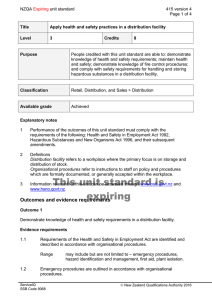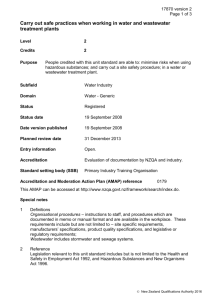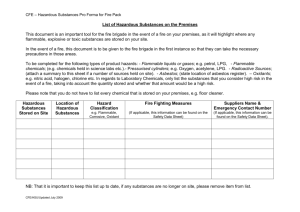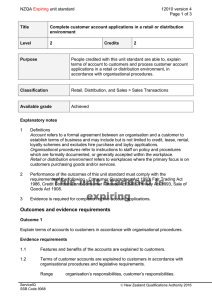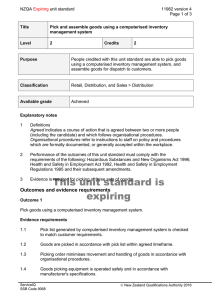NZQA unit standard 3254 version 7
advertisement
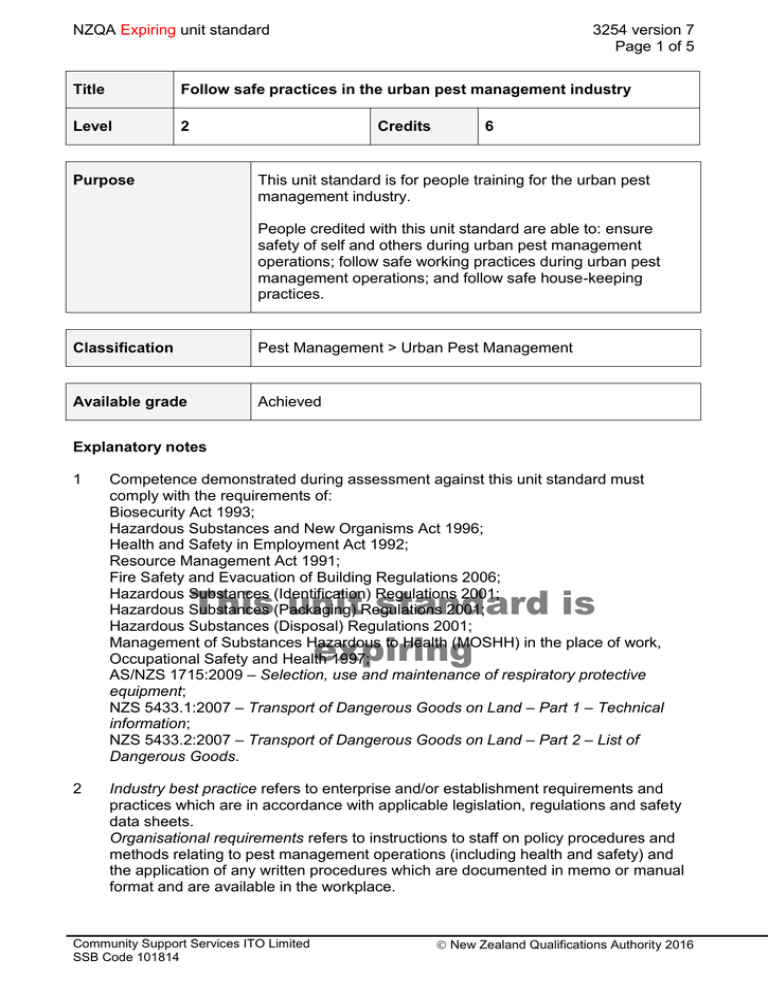
NZQA Expiring unit standard 3254 version 7 Page 1 of 5 Title Follow safe practices in the urban pest management industry Level 2 Credits Purpose 6 This unit standard is for people training for the urban pest management industry. People credited with this unit standard are able to: ensure safety of self and others during urban pest management operations; follow safe working practices during urban pest management operations; and follow safe house-keeping practices. Classification Pest Management > Urban Pest Management Available grade Achieved Explanatory notes 1 Competence demonstrated during assessment against this unit standard must comply with the requirements of: Biosecurity Act 1993; Hazardous Substances and New Organisms Act 1996; Health and Safety in Employment Act 1992; Resource Management Act 1991; Fire Safety and Evacuation of Building Regulations 2006; Hazardous Substances (Identification) Regulations 2001; Hazardous Substances (Packaging) Regulations 2001; Hazardous Substances (Disposal) Regulations 2001; Management of Substances Hazardous to Health (MOSHH) in the place of work, Occupational Safety and Health 1997; AS/NZS 1715:2009 – Selection, use and maintenance of respiratory protective equipment; NZS 5433.1:2007 – Transport of Dangerous Goods on Land – Part 1 – Technical information; NZS 5433.2:2007 – Transport of Dangerous Goods on Land – Part 2 – List of Dangerous Goods. This unit standard is expiring 2 Industry best practice refers to enterprise and/or establishment requirements and practices which are in accordance with applicable legislation, regulations and safety data sheets. Organisational requirements refers to instructions to staff on policy procedures and methods relating to pest management operations (including health and safety) and the application of any written procedures which are documented in memo or manual format and are available in the workplace. Community Support Services ITO Limited SSB Code 101814 New Zealand Qualifications Authority 2016 NZQA Expiring unit standard 3254 version 7 Page 2 of 5 Outcomes and evidence requirements Outcome 1 Ensure safety of self and others during urban pest management operations. Evidence requirements 1.1 Personal Protection Equipment (PPE) is checked for damage prior to operations and non-operational or damaged equipment is reported in accordance with industry best practice and organisational requirements. 1.2 PPE for any pest management activity is selected and used during operations in accordance with industry best practice and organisational requirements. Range footwear, gloves, overalls, eye or face protection, head protection, respiratory protection, hearing protection, barrier cream, hand soaps. 1.3 PPE is cleaned and de-contaminated following all operations where contaminating or hazardous substances are used. 1.4 Personal safety procedures in accordance with industry best practice and organisational requirements are followed at all times during handling of chemical compounds and fumigants while performing pest management operations. 1.5 Actions taken in the event of accidents and emergencies are to protect the safety of self, company personnel, clients and the public and comply with the requirements of the Health and Safety in Employment Act 1992. 1.6 1.7 This unit standard is Safety instructions are checked, interpreted and complied with prior to handling expiring of chemical compounds and fumigants during pest management operations. Range examples of accidents and emergencies include – spillage, accidental poisoning, fire, security breach, vehicle accident. Evidence of any four required. Range safety instructions include – manufacturer’s instructions, Safety Data Sheets (SDS). Client is advised of hazard of treatments and pre- and post-treatment procedures in accordance with safety requirements specified for each treatment, industry best practice and statutory regulations. Outcome 2 Follow safe working practices during urban pest management operations. Range personal equipment includes – any four of – 5 or 8 litre hand tank, dusters, bait carrying case, electric lead and electric circuit breaker, ladder, first aid kit, list of chemicals in the vehicle in case of accident/emergency; Community Support Services ITO Limited SSB Code 101814 New Zealand Qualifications Authority 2016 NZQA Expiring unit standard 3254 version 7 Page 3 of 5 machinery includes – any three of – motor blower (knapsack sprayer), electric mister, electric fluid pump, pulsfog/swingfog, electric duster. Evidence requirements 2.1 All items of personal equipment and machinery are checked prior to use and unsafe or damaged and non-operational equipment and machinery is reported in accordance with industry best practice and organisational requirements. 2.2 All items of personal equipment and machinery are set up and operated in accordance with manufacturer's recommendations. 2.3 All items of personal equipment and machinery are cleaned and maintained in accordance with manufacturer's recommendations. 2.4 Residual current device or isolating transformer is safety checked before operation and used at all times during pest management operations. 2.5 Toxic and/or flammable substances are labelled in accordance with manufacturer’s recommendations, SDSs and regulations. Range 2.6 Hazardous Substances (Identification) Regulations 2001. Toxic and/or flammable substances are handled and stored in accordance with manufacturer’s recommendations, SDSs, and regulations. Range Hazardous Substances (Packaging) Regulations 2001. 2.7 Toxic and/or flammable substances are prepared in accordance with manufacturer’s recommendations and SDSs. 2.8 Toxic and/or flammable substances, residues and containers are disposed of in accordance with manufacturer’s recommendations, SDSs and regulations. This unit standard is Range Hazardous Substances (Disposal) Regulations 2001. expiring Community Support Services ITO Limited SSB Code 101814 New Zealand Qualifications Authority 2016 NZQA Expiring unit standard 3254 version 7 Page 4 of 5 Outcome 3 Follow safe house keeping practices. Range on-site, off-site, vehicle. Evidence requirements 3.1 All access and exit points are kept clean and free of debris and obstructions to comply with fire safety regulations. 3.2 All toxic and/or flammable substances are stored in original containers with original labels in accordance with manufacturer’s recommendations, SDSs, and comply with regulations. Range 3.3 Toxic and/or flammable substances are kept locked away at all times unless in use in accordance with industry best practice and organisational requirements. Range 3.4 Hazardous Substances (Packaging) Regulations 2001. on-site – lockable store; off-site – lockable containers; vehicle – windows rolled up, all doors locked. Vehicles used to transport toxic and/or flammable substances are kept locked away at all times unless in use in accordance with industry best practice and organisational requirements. Range includes – on-site: windows rolled up, all doors locked; off-site – locked premises. This unit standard is Range safety requirements include – one example from NZS 5433.1:2007. expiring 3.5 Safety procedures specified for the transportation of toxic and/or flammable substances are complied with at all times. 3.6 Buildings, contents and the surrounding environment are protected against damage during pest management operations in accordance with organisational requirements. Replacement information This unit standard, unit standard 3257, unit standard 3258, and unit standard 3259 were replaced by unit standard 28788 and unit standard 28791. This unit standard is expiring. Assessment against the standard must take place by the last date for assessment set out below. Community Support Services ITO Limited SSB Code 101814 New Zealand Qualifications Authority 2016 NZQA Expiring unit standard 3254 version 7 Page 5 of 5 Status information and last date for assessment for superseded versions Process Version Date Last Date for Assessment Registration 1 30 November 1996 31 December 2018 Revision 2 7 June 2000 31 December 2018 Revision 3 3 April 2001 31 December 2018 Review 4 26 July 2004 31 December 2018 Revision 5 14 April 2005 31 December 2018 Review 6 18 March 2010 31 December 2018 Review 7 16 April 2015 31 December 2018 Consent and Moderation Requirements (CMR) reference 0004 This CMR can be accessed at http://www.nzqa.govt.nz/framework/search/index.do. Please note Providers must be granted consent to assess against standards (accredited) by NZQA, before they can report credits from assessment against unit standards or deliver courses of study leading to that assessment. Industry Training Organisations must be granted consent to assess against standards by NZQA before they can register credits from assessment against unit standards. Providers and Industry Training Organisations, which have been granted consent and which are assessing against unit standards must engage with the moderation system that applies to those standards. Requirements for consent to assess and an outline of the moderation system that applies to this standard are outlined in the Consent and Moderation Requirements (CMR). The CMR also includes useful information about special requirements for organisations wishing to develop education and training programmes, such as minimum qualifications for tutors and assessors, and special resource requirements. This unit standard is expiring Community Support Services ITO Limited SSB Code 101814 New Zealand Qualifications Authority 2016
